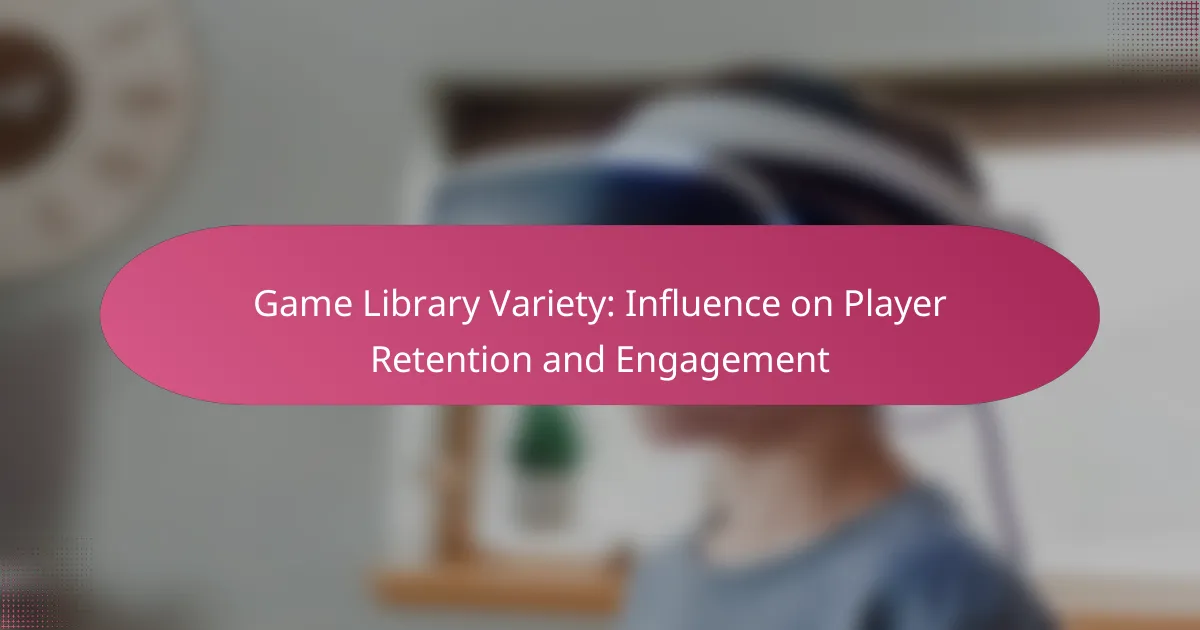The variety of a game library plays a crucial role in player retention and engagement by providing a fresh and dynamic gaming experience. A diverse selection caters to a wide range of preferences, encouraging players to return frequently and explore new titles. Additionally, subscription models enhance this variety, allowing players to access numerous games for a fixed monthly fee, fostering exploration and discovery without the burden of individual purchases.

How does game library variety impact player retention?
Game library variety significantly influences player retention by keeping the gaming experience fresh and engaging. A diverse selection of games caters to different preferences, encouraging players to return regularly and explore new titles.
Diverse genres enhance player engagement
Offering a wide range of genres, such as action, strategy, role-playing, and simulation, can greatly enhance player engagement. Players are more likely to stay interested when they can switch between different types of games that suit their mood or preferences.
For instance, a player who enjoys both fast-paced shooters and immersive RPGs will appreciate a library that includes both genres. This variety allows players to experience different gameplay mechanics and narratives, which can reduce monotony and increase overall satisfaction.
Increased player satisfaction through variety
Variety in a game library can lead to higher player satisfaction by providing options that meet diverse tastes. When players find games that resonate with their interests, they are more likely to invest time and money into the platform.
Additionally, introducing new titles regularly can keep the library feeling dynamic. Players often appreciate seasonal updates or themed events that introduce fresh content, which can lead to increased engagement and longer retention periods.

What are the key factors influencing player engagement?
Key factors influencing player engagement include game accessibility, availability, and the quality of game content. These elements significantly affect how often players return and how immersed they feel in the gaming experience.
Game accessibility and availability
Game accessibility refers to how easily players can access and play a game, while availability encompasses the platforms and regions where the game is offered. Ensuring that games are available on multiple platforms, such as consoles, PCs, and mobile devices, can broaden the player base and enhance engagement.
Additionally, considering regional availability is crucial. For instance, a game that is only available in certain countries may miss out on potential players. Offering localized versions and support for various languages can significantly improve player retention.
Quality of game content
The quality of game content directly impacts player satisfaction and retention. High-quality graphics, engaging storylines, and well-designed gameplay mechanics keep players invested in the experience. Regular updates and new content can also maintain interest over time.
Moreover, player feedback should be actively sought and incorporated into game development. This responsiveness helps create a community-driven environment where players feel valued, further enhancing their engagement. Developers should aim for a balance between innovation and stability to keep the content fresh while maintaining core gameplay elements that players love.

How can subscription models improve game library variety?
Subscription models enhance game library variety by offering players access to a diverse selection of titles for a fixed monthly fee. This approach allows players to explore different genres and discover new games without the financial commitment of purchasing each title individually.
Access to a broader range of titles
Subscription services typically include a wide array of games, spanning various genres and platforms. This variety encourages players to try titles they might not have considered purchasing outright, fostering a more inclusive gaming experience.
For example, platforms like Xbox Game Pass and PlayStation Now provide access to hundreds of games, including indie titles, AAA releases, and classic games. This extensive library can significantly enhance player engagement, as users can easily switch between games based on their mood or interests.
Regular updates and new releases
Many subscription models offer regular updates and the addition of new titles, keeping the library fresh and exciting for players. This continuous influx of content can help maintain player interest and encourage longer subscription durations.
For instance, services often feature day-one releases of new games, allowing subscribers to play the latest titles immediately upon launch. This strategy not only attracts new subscribers but also retains existing ones by providing ongoing value and novelty.

What are the best practices for game library management?
Effective game library management involves curating a diverse selection of games and utilizing player feedback to enhance the gaming experience. These practices help maintain player engagement and retention by ensuring that the library remains appealing and relevant to users.
Curating diverse game selections
Curating a diverse game selection is crucial for attracting and retaining players. A well-rounded library should include a mix of genres, styles, and difficulty levels to cater to different preferences. For instance, incorporating action, strategy, puzzle, and simulation games can appeal to a broader audience.
Consider regularly updating the library with new titles while also including classic games that players may enjoy. Aim for a balance between popular mainstream games and indie titles to provide unique experiences. A good practice is to refresh the library quarterly to keep content fresh and engaging.
Utilizing player feedback for improvements
Player feedback is a valuable resource for improving game library management. Actively solicit input through surveys, forums, or social media to understand player preferences and pain points. This feedback can guide decisions on which games to add or remove from the library.
Implementing changes based on player suggestions can significantly enhance user satisfaction. For example, if players express a desire for more multiplayer options, prioritize adding games that support this feature. Regularly reviewing feedback and making adjustments can foster a loyal player base and improve overall engagement.

How do different platforms compare in game library offerings?
Different gaming platforms offer varying game libraries, which can significantly impact player retention and engagement. Factors such as subscription models, exclusive titles, and the breadth of available genres play crucial roles in how players interact with these platforms.
Xbox Game Pass vs. PlayStation Plus
Xbox Game Pass provides access to a large library of games for a monthly fee, including new releases and exclusive titles. This model encourages players to explore a variety of genres without the commitment of purchasing individual games, which can enhance engagement.
In contrast, PlayStation Plus offers a tiered subscription service with access to a selection of games, online multiplayer, and exclusive discounts. While it may not match the sheer volume of Xbox Game Pass, it includes critically acclaimed titles that can attract dedicated players.
Steam vs. Epic Games Store
Steam boasts one of the largest game libraries available, featuring thousands of titles across various genres. Its user-friendly interface and community features, such as reviews and forums, foster a vibrant gaming community that can enhance player retention.
The Epic Games Store, while smaller, often provides free games and exclusive titles that can draw players in. Its promotional strategies, such as limited-time offers, create urgency and encourage players to engage with the platform regularly.

What metrics should be used to measure player retention?
To effectively measure player retention, focus on metrics like active user engagement rates and churn rates. These metrics provide insights into how often players return to the game and their likelihood of continuing their subscriptions.
Active user engagement rates
Active user engagement rates indicate how frequently players interact with a game over a specific period. This metric can be tracked daily, weekly, or monthly, depending on the game’s nature and player habits. A higher engagement rate typically correlates with better retention.
To calculate this rate, divide the number of active users by the total number of registered users within the same timeframe. For example, if a game has 1,000 active users out of 10,000 registered players, the engagement rate is 10%. Aim for engagement rates in the low to mid-teens for optimal retention.
Churn rates and subscription renewals
Churn rates measure the percentage of players who stop playing a game or cancel their subscriptions over a given period. A high churn rate can signal issues with game content or player satisfaction. Monitoring this metric helps identify when players are likely to disengage.
To calculate churn, divide the number of players lost during a period by the total number of players at the start of that period. For instance, if you start with 1,000 players and lose 100, your churn rate is 10%. Aim to keep churn rates below 5% for subscription-based models.
Subscription renewals are closely related to churn rates and indicate how many players choose to continue their subscriptions. Tracking renewal rates can help assess the effectiveness of retention strategies, with a target of 70% or higher being a good benchmark for many games.

How can developers enhance player experience through game variety?
Developers can significantly enhance player experience by offering a diverse range of game types, genres, and content. This variety keeps players engaged and encourages them to return to the game, as they can find new experiences that cater to their evolving interests.
Incorporating player-driven content
Integrating player-driven content allows gamers to contribute their ideas and creations, fostering a sense of ownership and community. This can take the form of user-generated levels, character customization, or even narrative choices that affect gameplay.
To implement this effectively, developers should provide robust tools for content creation and clear guidelines to ensure quality. Regularly featuring player creations can also motivate others to participate, enhancing overall engagement.
Expanding cross-platform capabilities
Cross-platform capabilities enable players to connect and compete regardless of the device they use, which broadens the player base and enhances social interactions. This approach can lead to increased retention as friends can play together, regardless of whether they are on consoles, PCs, or mobile devices.
When developing cross-platform features, consider the technical challenges such as balancing gameplay and ensuring seamless communication between different systems. Offering incentives for cross-platform play, like exclusive rewards, can further encourage players to engage with the game across multiple platforms.

What emerging trends are shaping game library variety?
Emerging trends in game library variety are significantly influenced by technological advancements and changing player preferences. Key factors include the rise of cloud gaming, subscription models, and the integration of cross-platform play, all of which enhance accessibility and engagement.
Cloud gaming advancements
Cloud gaming is revolutionizing how players access and enjoy games, allowing them to stream titles directly without the need for high-end hardware. This technology enables a broader variety of games to be available instantly, catering to diverse player interests.
With services like NVIDIA GeForce NOW and Google Stadia, players can enjoy high-quality gaming experiences on various devices, from smartphones to smart TVs. This flexibility encourages longer play sessions and increased retention, as players can engage with their favorite titles anytime, anywhere.
However, players should consider their internet connection quality, as latency can affect gameplay. A stable connection with low latency is crucial for an optimal experience, typically under 30 ms for competitive gaming. Investing in a good internet plan can enhance cloud gaming performance significantly.
